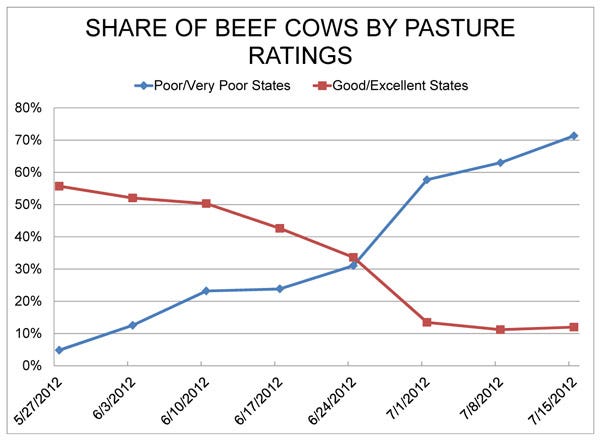71% Of Beef Cows In States With Lowest Pasture Conditions
The percentage of total pasture acres rated as being in poor or very poor condition increased to 54% this week, up 4% from one week ago. That number compares to 29% last year at this time.
July 20, 2012

USDA will release this afternoon (Friday) its semi-annual estimate of total cattle numbers. This report will provide the government’s first estimate of the 2012 calf crop which, given the sharp decline in beef cow numbers last year, will almost surely be significantly lower than that of 2011. In addition, the report will provide figures for the numbers of beef and dairy cows on farms as of July 1 as well as the numbers of younger cattle being held for feeding and breeding.
One confounding factor in these numbers this year will be the rapid deterioration of range and pasture conditions. The percentage of total pasture acres rated as being in poor or very poor condition increased to 54% this week, up 4% from one week ago. That number compares to 29% last year at this time.
Recall that most of that 29% in 2011 was in Texas and Oklahoma – the two largest beef cow states. Those two states are in much better condition this year but 40% of their pastures are still in the P/VP category.
This year’s drought conditions are much more widespread and are now impacting the vast majority of beef cows. The accompanying chart is based on data compiled by the Livestock Marketing Information Center in Denver. It simply shows the percentage of all beef cows in the U.S. that are located in states in the two condition ranking groups – poor/very poor and good/excellent. As of this week, 71% of the nation’s beef cows are located in poor and very poor states.

Perhaps more importantly, that percentage has more than doubled in just three weeks. Conversely, only 10% of beef cows are in states that now have good/excellent pasture ratings. It should be noted that these are, to some degree, naturally selecting groups as a high proportion of beef cows are always located in more arid and drought-prone states. States that usually get more rainfall tend to find higher value uses for their land. But the magnitude of the poor/very poor percentages is still large and the speed with which it has grown is rather shocking.
What does this mean? Cattle numbers could have changed even since July 1 – or at least decisions are being made now that could change those numbers. This could be much like the “Kept for Breeding” number in the June Hogs and Pigs report that said farms were keeping 1% more animals for breeding. That number may have been (and we think the probability is high that is was!) wrong by the time it was published. The situation for pork producers has obviously gotten worse since June 29 and the situation for beef cow owners could get worse in weeks to come.
We aren’t trying to torpedo USDA’s numbers before they are published. We are simply point out that when conditions change this quickly, some of these estimates may have a pretty short shelf life and that fact must be at least considered.
Is there some help on the way? That depends on where you live. The 6-10-day precipitation forecast from the National Weather Service indicates a reasonable chance of above-normal rainfall for large parts of Arizona, New Mexico, Colorado and Utah. But much of the Midwest, Southwest and Southeast have high probabilities of below-normal rainfall, and the Great Plains (Nebraska, the Dakotas, Montana, Wyoming) are expected to have “normal” rainfall. And we need to remember that normal rainfall in July and August in these areas may not amount to enough moisture to settle the dust.
You May Also Like



